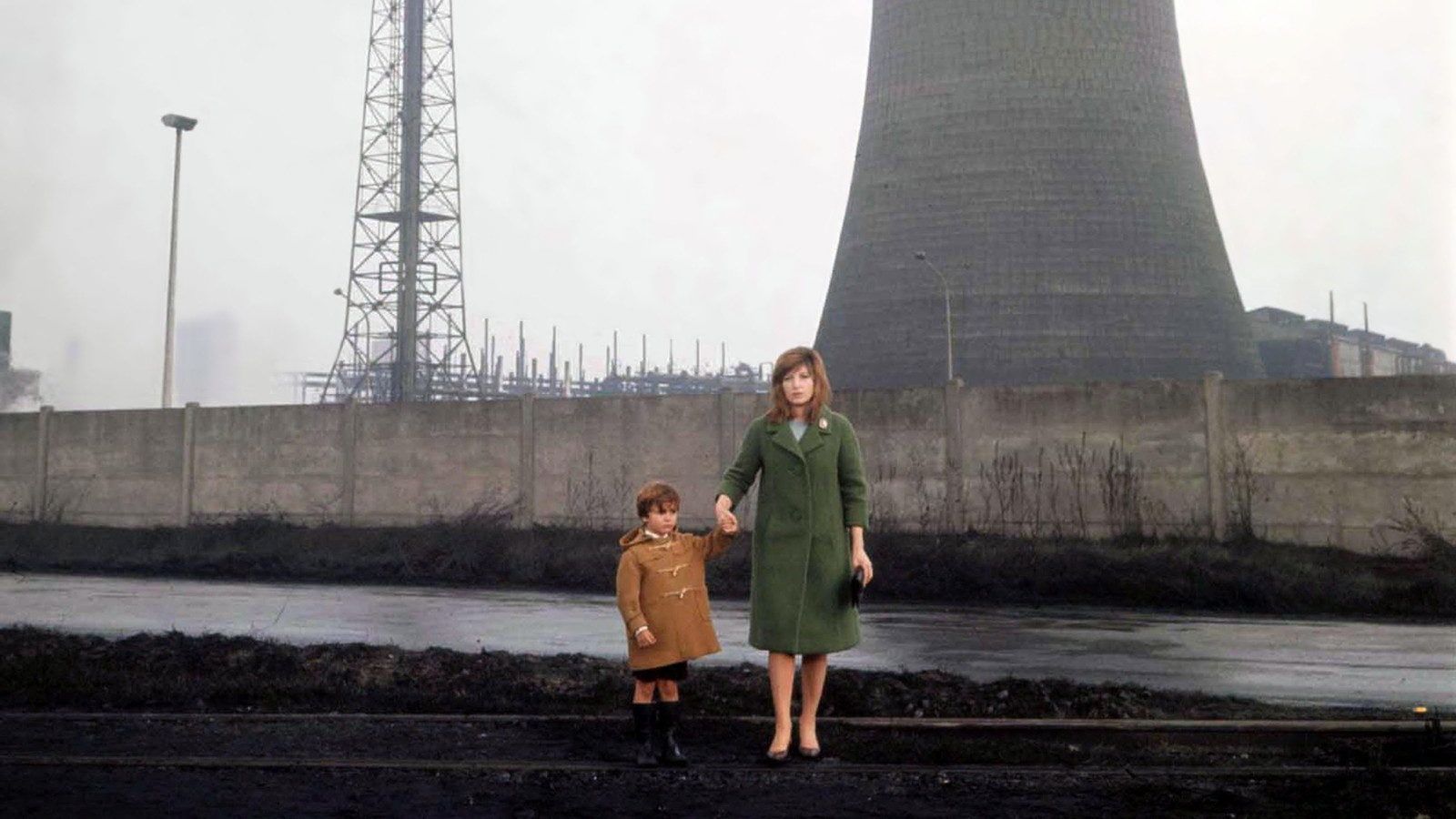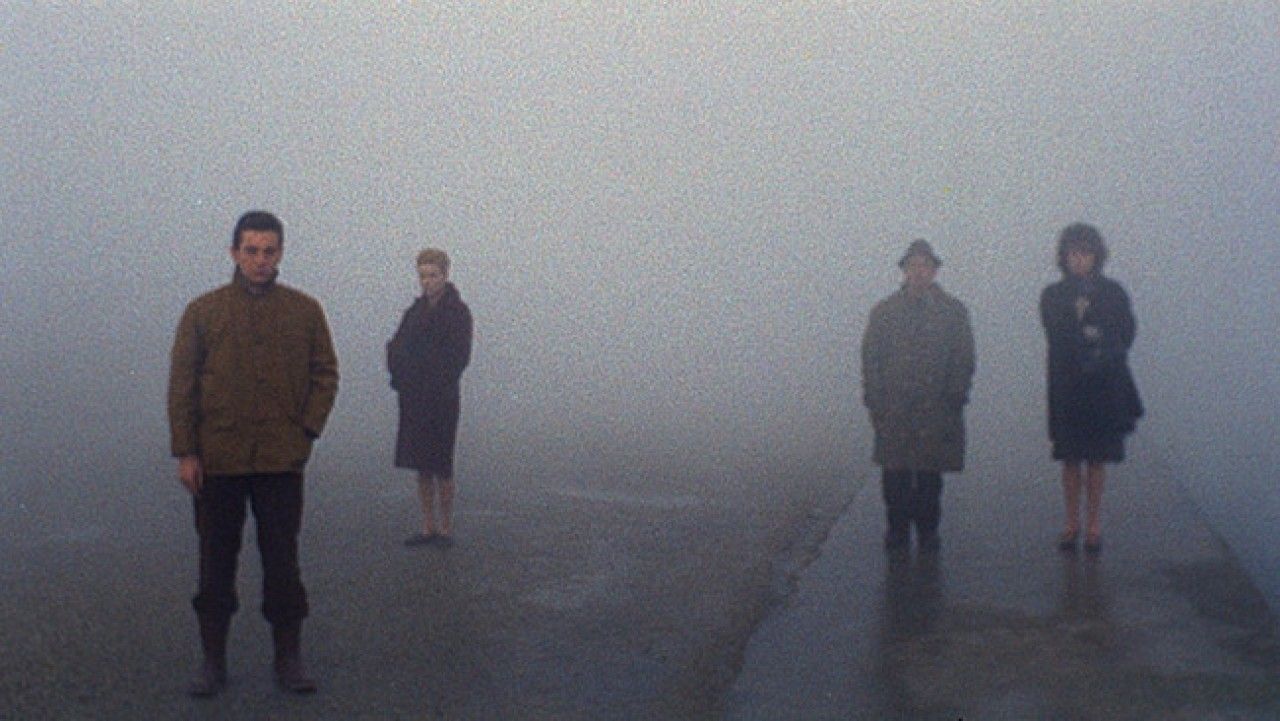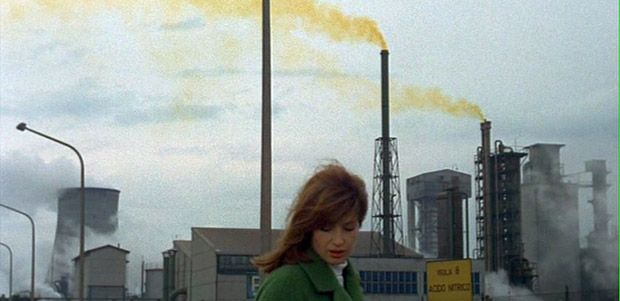Red Desert
I re-watched Red Desert, the 1964 Antonioni flick, this week. Giuliana (Monica Vitti) wanders—accompanied by either her young son Valerio, or love interest (and husband’s colleague) Zeller—around post-War Ravenna and its surrounding industrial landscape. Flames shoot from the towers of petrochemical plants; old ditches serve as trash heaps; the earth is washed-out, the sky a dreary gray.

Coastal fog, smoke, and pollution from the factories constantly obscures the characters’ views; the world comes in and out of sight. Sometimes we see the world—for just a second—from Giuliana’s view, and it looks radically different than the “objective” image of the camera.

As in Cassavetes’s Woman Under the Influence, our heroine is a housewife and young mother who slips in and out of sanity, slowly losing her grasp on reality. What is unclear, however, is the extent to which that reality is physical versus social.
In a scene which serves as the film’s centerpiece, Giuliana, her husband, and two other couples camp out in an old shack on unused docks, burning its slats for heat. The port had once been a center of commerce, but the slick ooze of petrol and chemicals now covers its surface. The couples drink wine and eat quail eggs, and talk in alluring tones about the eggs’ supposed aphrodisiac effects. Each takes their turn eating an egg and performing for the group: we see Giuliana down two, then pause thirty seconds before beginning to sway sensually. The social recognition of the eggs’ effects gives them their power—no chemical, orally ingested could possibly kick in so quickly, let alone on a full stomach.
At some point, a large cargo ship pulls up in the empty port, unexpected and unusual. It raises a single yellow flag, and the men of the party debate whether or not the raised flag is a signal of illness on board. One of the wives comments—“That must have been what the cry was about”—and the men ask, “What cry? We didn’t hear a cry.” She insists but falters; perhaps it was imagined, perhaps it was an idea given her by the book she’s been reading, the allege. “Maybe,” she says, caving.
But Giuliana now joins the fray, insisting that she too heard a cry of distress earlier. Now it becomes a scene: the men alleging that she is making a scene, taking a stand to take a stand, or defend her friend. It becomes a gendered conflict very quickly, if it wasn’t already. When a doctor arrives, and then an ambulance, evidence shifts toward the women, but this shift goes unacknowledged.
When I watched Red Desert with Nico, I never heard a cry either, but she did. When we debriefed afterwards, she talked a lot about the soundtrack, the jarring industrial noises and unnerving alarm-like sound effects. She tied Giuliana’s psychological distress to the sensory bombardment of a hostile industrial landscape. I didn’t notice any of those, I told her. But it seems correct, as an interpretation of the movie’s themes. At one point, Giuliana’s son asks about noxious yellow smoke being released from factory stacks; she tells him the gases are poisonous. He asks whether, if a bird flew through the fumes, it would get sick or die, and she comforts him: No, no, the birds have learned by now to steer clear.

There’s a long history in Western thought of casting men as rational, women as feeling. There’s a lot of prejudice in this account, and an emphasis on difference rather than continuity. But if there’s a small kernel of truth in this account, it might be found in the predictive processing paradigm of top- and bottom-heaviness.
Very briefly, the idea of predictive processing is that we constantly make guesses (predictions) about our environment, then learn from the error—the differential between prediction and subsequent (perceived) events. Friston’s free energy, a version of this model, makes very specific, controversial claims about how the brain works—but in its generic form, the predictive processing theory is very much aligned with a long history of Western thought about schematic learning and cognitive modeling from Kant to Piaget to Gestalt theory.
“Top” here refers to high-level hypotheses which alter and affect bottom-up sensory experience—for instance, a placebo changing how your body experiences pain. With little top, the world resemble’s James’s “buzzin’ bloomin confusion”; with little bottom, we fall into heavy denialism, confirmation bias, and delusion.
In Red Desert, the men are always trying to reduce Giuliana’s experience—and the experience of other women—to some rationalistic formal system, top-down. At points—such as with the cry on the docks—this rationalizing approaches gaslighting. And yet, if the cry is there, the men are merely less perceptive! Near the film’s end, Giuliana’s young son Valerio fakes paralysis, sending her into a panic. She tests his reflexes, stands him up, tempts him, but he defies her suspicions and maintains the paralysis. He is authoring a social reality for her, manipulating her with it (to avoid kindergarten). When she catches him, some hours later, getting out of bed to grab a toy from the table, she is first overjoyed, then distraught. Throughout the film, one implicit question has been, how does this little boy, Valerio—her son, her ward—turn into someone like her husband, or like Zeller—a man who alters and controls her understanding of the world. And this deception is such a tipping point. He doesn’t need me anymore, she tells Zeller; my son doesn’t need me. Already he is authoring the reality I inhabit, rather than living in mine.
I think a lot about top-heaviness and bottom-heaviness. I think a lot of leading or managing an organization looks like creating and maintaining a shared social reality around which lower-level members synchronize, allowing coordination. The CEO constructs a narrative, which guides and influences decisions of both employees and investors. Hence—perhaps—the stereotype of the high-powered executive who likes to be tied up in his/her afterhours—a complete renunciation of narrative control. And is it really a coincidence, “topping” and “bottoming” in a sexual context? Production versus consumption—of desire, of experience.
Psychedelics, a la REBUS, relax priors, make experience less top-heavy. I don’t think it’s a coincidence that one of the most common psychological effects of psychedelics is boundary dissolution, between oneself and one’s environment. A greater permeability, a reduced ability to filter out: one can imagine that, tripping across the harsh industrial landscape of Red Desert, we might go mad like Giuliana.
If there is a difference in men and women’s “top-heaviness” or “bottom-heaviness,” it is much smaller than the similarity in our processing, and I think it would be a mistake to take this carving too seriously. More obvious is the ossification which comes with age: the way that neuroplastic young minds become close-minded and unable to learn as they grow up. It’s not that ossified minds go out intending to impose social reality on people: it’s that their perception has naturalized, that it’s hard not to live in a world, around people, without imposing your narrative, especially when you have the status or power to force others to adapt around you. And perhaps that’s what the man/woman dichotomy is really about: Men impose their systems and social realities because historically, they have had the power to. Because for them, their personal perception has always been the reality, rather than mere perception.
This is the biggest mistake, and it is the nemesis of generalized compatibilism, or standpoint epistemology. The biggest problem with the American left is not its belief in social construction or standpoint epistemology: it is that it pays lip service to these ideas when convenient, while turning around and naturalizing all its own eccentric perceptions and value judgments as “natural rights,” the product of an “inevitable arc of moral progress.” But that arc is a product of hindsight, not foresight.